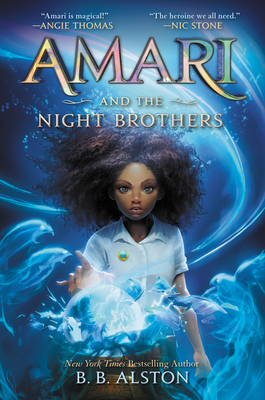craft review by Kristi Wright
As Anne-Marie Strohman mentioned last week, too much backstory can drag down the pace of a story. Too little, and there’s a lack of clarity for the reader about why characters do what they do and why the plot is moving in a particular direction. It’s a difficult balancing act.
Amari and the Night Brothers by B. B. Alston is an excellent mentor text for how to interweave backstory, using multiple techniques, without slowing down the story one bit. NOTE: this blog post has spoilers. I highly recommend reading the novel before you dive into this analysis. It’s an inventive, fast-paced adventure fantasy. You will not regret it!
In Amari and the Night Brothers, Alston has multiple threads that require information from the past. In this post, I’ll concentrate on one specific thread: Amari’s brother and his mysterious job and equally mysterious disappearance. No reader wants a big info dump at the beginning of the book to set the stage. Fortunately, Alston gives a masterclass in how to provide readers with the information they need when they need it, through slow and big reveals using both traditional and creative techniques.
Backstory Through Traditional Methods
Alston starts his novel fully in the present, with the main character, Amari, in trouble at school. In the first four pages, there’s only one hint of backstory.
I glance up at the picture of the brown-skinned boy on the wall behind Principal Merritt’s desk and frown. Quinton proudly holds up the trophy he won in the state math competition. You can’t see, but me and Mama are just off-stage, cheering him on.
There’s not much to cheer about anymore. (2)
Readers can already deduce that Quinton is Amari’s brother, that he’s a hard act to follow, and that something bad has happened since that picture was taken. The readers get a whiff of backstory and even better, they are intrigued. When readers are intrigued, they turn pages.
Also, Alston didn’t just dryly tell his readers that Quinton is Amari’s star-student brother. No, he seeds a photo behind the principal’s desk, and he gives Amari the chance to have an emotional reaction to it.
Two pages later, Alston provides backstory via dialogue to reinforce the Quinton mystery:
“I know that it’s been… difficult,” says Principal Merrit to me, “since Quinton’s disappearance. He was a great kid with a truly bright future. It doesn’t take a rocket scientist to connect the dots between that incident and the start of your behavior problems, Amari. I can arrange for you to talk to a counselor, free of charge–” (4)
Finally, on the next page, we receive a bigger infodump via Amari’s interior thoughts as they ride home from the principal’s office. This page of backstory feels earned because of the opening scene, which has given us both a relatable character and a mystery we want to learn more about.
We ride home in silence. It’s been almost six months since Quinton went missing, but it doesn’t feel that long. Seems like just the other day he was calling Mama’s phone to say he’d be home for Christmas. It was a big deal because Quinton was always gone once he got that fancy job after high school. The kind where you can’t tell anybody what you do.
I used to swear up and down that Quinton was some super-secret spy like James Bond. But he would just give me this little smirk and say, “You’re wrong, but you’re not totally wrong.” (5)
Amari’s thoughts go on to tell the reader how smart Quinton was and how he turned down full scholarships from Ivy league universities. How he used to send money home to help out with the bills. But then readers find out that the detectives who investigated his disappearance found no evidence that he ever had a job. They suspect he was involved in something illegal, which Amari knows is impossible.
This larger infodump works because readers are already invested in the mystery. They want to hear more. It’s the right “when.” And even more importantly, it doesn’t answer all the questions. In fact, it adds to the mystery. Why is there no evidence that he had a job? Where did the money come from? Was he doing something illegal? More page turns!
So far, Alston has used pretty standard techniques for his backstory reveals–character interiority and dialogue. But he doesn’t stop with those devices. He’s got more tricks up his sleeve.
Backstory in Unexpected Ways
The Quinton mystery is a slow reveal throughout the book. And Alston finds unexpected ways to feed new pieces of the puzzle to readers, many of which also add to the fantastical world-building.
In chapter 3, Amari receives a mysterious briefcase (later revealed to be a Farewell Briefcase from Quinton) that pulls her into a Wakeful dream where Quinton appears and they fly in a wondrous ship, seeking out wondrous things. He acknowledges that she wouldn’t be in this interactive Waking dream recording unless he was missing or dead. He ends this mysterious and magical encounter–and the chapter–with the revelation that he’s nominated Amari for something. Readers have to dig into the next chapter to find out that she’s been nominated to attend a special and mysterious summer camp.
As part of the summer camp start-up kit, Amari’s given a book with blank pages called, One Thousand and One Careers. When she puts in True Sight eye drops, the book is filled with words, some of which supply backstory to the reader, such as confirmation that Amari’s brother was an agent for the Department of Supernatural Investigations.
When Amari attends this special summer camp for the Bureau of Supernatural Affairs, she meets supernatural beings who have knowledge of her brother–he’s a bit of a rockstar in their community. Quinton’s young fans tell her all sorts of backstory about her brother and his partner, Maria Van Helsing. Amari learns that Quinton and his partner even have a nickname: VanQuish (68)
One of my favorite devices is a magical gossip magazine called Rumors and Whisperings that has headlines about Amari’s brother but won’t reveal the article until she asks the right question:
“Fine,” I say. “Can you please tell me about the Special Agent keeping secrets?”
“Why certainly,” the magazine replies. An image of Agent Magnus appears on the page.
“Psst, listen up Special Agent Quinton Peters is known for his heroics as one half of the fame agent team VanQuish. The pair went missing under highly suspicious circumstances about which the bureau has remained extremely tight-lipped. But maybe they’re seeking to protect his legacy more than anything…” (321)

At first the magazine article regurgitates (in a gossipy way) information that readers already know, but then it reveals an exciting twist. It claims that Quinton left behind two Farewell Briefcases. In addition to the one that Amari received in the beginning of the book, rumor has it that Quinton left a second Farewell Briefcase in the care of one of his fellow agents. This huge revelation, done in a fun, magical way, springs Amari into action. Now she must uncover what’s in that second briefcase in the hopes that it will bring her closer to the truth about Quinton’s disappearance. Yet again, more intrigue and more page turns!
In Amari and the Night Brothers, backstory for Quinton’s mystery and other major threads is revealed in a recursive manner, each time adding to the reader’s knowledge. Alston doesn’t just rely on interior thought and dialogue to feed backstory to readers. He also uses (to name a few) magical elements, radio, books and magazines, and primary sources. Backstory revelations answer reader questions and prompt readers to ask more questions, thus instigating more page turns.
Now it’s Your Turn
For your own work-in-progress:
- Tee-up backstory with a quick hint early in your story that provides intrigue for the reader.
- Break up the backstory details into pieces that answer at least some of the questions already teed-up and then prompt readers to ask more questions, leading to more page turns.
- Brainstorm creative ways to provide your backstory to readers. Interior thoughts and dialogue are great, but what else can you do to integrate your backstory into your worldbuilding and action?
For more discussion about effective backstory, here’s a blogpost by Beth Mitchell that analyzes ONE CRAZY SUMMER by Rita Williams-Garcia
Kristi Wright (co-editor) writes picture books and middle grade novels. Her goal as a writer is to give children a sense of wonder, a hopefulness about humanity, and a belief in their future. She is represented by Kurestin Armada at Root Literary. She is an active volunteer for SCBWI and a 12 X 12 member. Find her at www.kristiwrightauthor.com and on Twitter @KristiWrite.



COMMENTs:
0